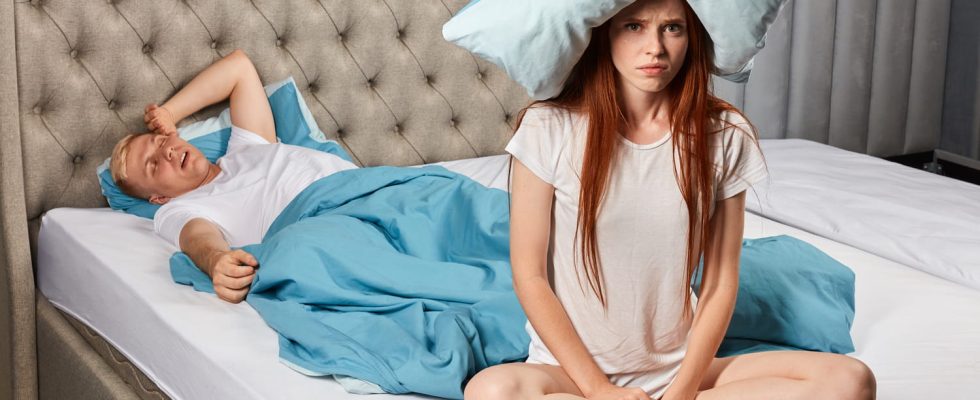Sleep apnea is a disorder that manifests itself during sleep by involuntary cessations of breathing. It can lead to serious long-term complications increasing the risk of mortality.
Sleep apnea is a breathing disorder which occurs during sleep. What is the cause ? What are the symptoms ? What test to diagnose it? What is the treatement ? Answers.
Definition: what is sleep apnea?
Also called “obstructive sleep apnea-hypopnea syndrome (OSAS)”, sleep apnea is a nocturnal breathing disorder. It is characterized by the occurrence of pauses in breathing of at least 10 seconds which can sometimes repeating more than 100 times a night. This respiratory dysfunction is caused by theobstruction of the airways in the back of the throat. Sleep apnea was first described in 1972 by the French teacher Christian Guilleminault.
What are the symptoms of sleep apnea?
- a abnormal fatigue on waking after a night’s sleep and headaches upon rising.
- A abnormal and frequent drowsiness during the dayafter meals, in front of the television, at the cinema, while reading, in meetings or even while driving.
- Behavioral disorders can be observed: irritability, difficulty concentrating, memory loss, lack of energy and depression.
- Decreased desire and erectile dysfunction can be observed.
- A decrease in blood oxygenation. This decrease in oxygenation has severe repercussions on health by favoring the appearance of arterial hypertension, myocardial infarction or cerebrovascular accident.
- A snoring very often permanent. It begins at the onset of sleep and is interrupted by pauses in breathing, often described by the spouse. The resumption of breathing is noisy and is accompanied by body movements.
- Of the night sweats and episodes of somnambulism in about 10% of cases.
What are the causes of sleep apnea?
Sleep apnea is caused by upper airway obstruction the causes of which may be multiple:
- dilation of the pharynx,
- obstruction of the nasal passages,
- increase in the size of the tonsils, tongue or uvula.
It is often accentuated by lying on your back which drags the tongue into the back of the throat. heredity would also be a risk factor.
What are the dangers and consequences of sleep apnea?
Lack of restorative sleep causes a state of abnormal tiredness. It is manifested by frequent drowsiness during the day, especially while driving. THE risk of road accident would thus be multiplied by 6 in people prone to sleep apnea. According to Dr. Samia Tahraoui, sleep specialist in Paris “sleep apnea can lead to serious long-term complications (hypertension, stroke, diabetes, overweight) increasing the risk of cardiovascular mortality. This is a real public health problem unfortunately currently under-diagnosed”. It is in fact estimated that nearly 80% of people who suffer from sleep apnea go undiagnosed. It would therefore be more than 20% of the population who would be affected by these disorders and no longer only 5 to 10%.
“The diagnosis is made in two step the first essential of which is the Berlin quizperformed by the doctor, explains Dr. Tahraoui, the answers to this questionnaire allow him to assess the probabilities of sleep apnea, and in the event of a high probability, two types of examination are then offered to the patient. These exams are:
>> A ventilatory polygraphy: an outpatient medical examination that records breathing rate, snoring and body movements during sleep using a small, portable device called an outpatient polygraph.
>> A polysomnography: an examination that also records heart rate, electroencephalogram (brain activity) and electromyogram (muscle activity) and body temperature.
What are the treatments for sleep apnea?
Before starting treatment, it is essential toeliminate factors that can cause or worsen sleep apnea. In case of overweight or obesity, losing weight is an essential measure that must be taken as soon as the sleep apnea syndrome is diagnosed. The relationship between overweight and weight gain is indeed important. Nearly one obese person out of two has a sleep disorder.
- Avoid the consumption of substances that aggravate snoring: alcohol, tobacco, taking sedatives or tranquilizers.
- sleep on the side and no longer on the back, can sometimes reduce the frequency of sleep apnea and improve sleep.
What is a sleep apnea device used for?
Many people with sleep apnea syndrome are offered thedevice allowing the Continuous Positive Pressure (CPAP). Unfortunately, nearly 30% of patients do not accept this treatment and a sizeable percentage of those who use it don’t plug it in all night long. As a result, they do not benefit from the minimum number of hours required for the treatment to be effective. The success of CPAP treatment relies on a rigorous therapeutic education so that he and his family, in particular his spouse, accept this constraining apparatus. The prescribing doctor and the service provider who installs the device must provide a certain amount of information that is essential for the smooth running of this treatment. This step allows you to become familiar with and better accept the device.
Anti-snoring gutters: for whom?
Also called anti-snoring gutter, the mandibular advancement orthosis (OAM) is used in cases of moderate sleep apnea. This custom-made mouthguard made by an orthodontist must be worn all night. It has the function of keeping the tongue and lower jaw forward to prevent obstruction of the airways.
When to consider an operation?
The operation is rarely offered as a treatment for sleep apnea, and is only offered to correct a possible morphological defect of the jaw, palate or base of the tongue. It is quite painful and often ineffective.
Thanks to Dr. Samia Tahraoui, sleep specialist in Paris
